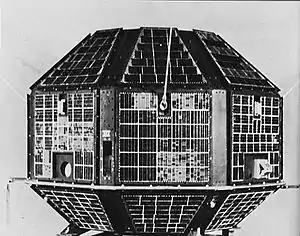 CartoSat-2F satellite | |||||||||
| Names | CartoSat-2F CartoSat-2ER | ||||||||
|---|---|---|---|---|---|---|---|---|---|
| Mission type | Earth Observation | ||||||||
| Operator | ISRO[1] | ||||||||
| COSPAR ID | 2018-004A | ||||||||
| SATCAT no. | 43111 | ||||||||
| Website | https://www.isro.gov.in/ | ||||||||
| Mission duration | 5 years (planned) 6 years and 2 days (in progress) | ||||||||
| Spacecraft properties | |||||||||
| Spacecraft | CartoSat-2F | ||||||||
| Bus | IRS-2[2] | ||||||||
| Manufacturer | Indian Space Research Organization | ||||||||
| Launch mass | 710 kg (1,570 lb) | ||||||||
| Power | 986 watts | ||||||||
| Start of mission | |||||||||
| Launch date | 12 January 2018, 03:59 UTC | ||||||||
| Rocket | Polar Satellite Launch Vehicle-XL, PSLV-C40 | ||||||||
| Launch site | Satish Dhawan Space Centre, First launch Pad (FLP) | ||||||||
| Contractor | Indian Space Research Organisation | ||||||||
| Entered service | 12 April 2018 | ||||||||
| Orbital parameters | |||||||||
| Reference system | Geocentric orbit | ||||||||
| Regime | Sun-synchronous orbit | ||||||||
| Periapsis altitude | 505 km (314 mi) | ||||||||
| Apoapsis altitude | 505 km (314 mi) | ||||||||
| Inclination | 97.47° | ||||||||
| Period | 94.72 minutes | ||||||||
| |||||||||
Cartosat-2F is the eighth satellite in the Cartosat-2 Series. It is an Earth observation satellite launched on the PSLV-C40 mission by the Indian Space Research Organisation (ISRO).[3]
History
Originally, Cartosat-2E was published as the last Cartosat-2 satellite to be launched, as Cartosat-3 Series spacecraft were scheduled to launch in 2018. Cartosat-2F was first listed on launch schedules as Cartosat-2ER, a name possibly indicating it was originally a replica of Cartosat-2E to be used as a spare.[4]
Satellite description
Like other satellites in the series, Cartosat-2F was built on an IRS-2 bus. It uses reaction wheels, magnetorquers, and hydrazine-fueled reaction control thrusters for stability. It has a design service life of five years.[5] Cartosat-2F has three main remote sensing instruments, a panchromatic camera called PAN, a four channel visible/near infrared radiometer called HRMX, and a Event Monitoring camera (EvM).[3]
- Panchromatic camera (PAN) is capable of taking panchromatic (black and white) photographs in a selected portion of the visible and near-infrared spectrum (0.50–0.85 µm) at a resolution of 65 cm (26 in).[6]
- High-Resolution Multi-Spectral (HRMX) radiometer is a four-channel radiometer sensitive across the entire visible spectrum and part of the near-infrared spectrum (0.43–0.90 µm) at a resolution of 2 m (6 ft 7 in).[7]
- Event Monitoring camera (EvM) is also capable of capturing minute long video of a fixed spot as well, Event Monitoring camera (EvM) for frequent high-resolution land observation of selected areas.[8]
Launch

The PSLV-C40 launch was initially placed on hiatus following failures with the nose cone and satellite deployment systems of PSLV-C39, but was cleared to launch once these issues were resolved.[9] It was launched at 03:59 UTC from First Launch Pad at Satish Dhawan Space Centre on 12 January 2018,[10] the third of the series to be launched within a year.[5] After 16 minutes and 37 seconds, Cartosat-2F was separated from the launch vehicle, and the ISRO Telemetry, Tracking and Command Network (ITTCN) took control of the satellite for maneuvers to its desired orbit.[10] The launch also marked the 100th satellite successfully put into orbit by the ISRO.[11]
Mission
The first image returned by the mission, on 15 January 2018; was of Holkar Stadium and the surrounding community in Indore, Madhya Pradesh.[12] The PAN camera is designed to have a spatial resolution less than one meter and a swath width of ten kilometers.[2]
On 27 November 2020, at 01:49 UTC, Cartosat-2F and Russia's Kanopus-V No.3 spacecraft came very close while in orbit, passing each other at distance of nearly 200 to 450 meters.[13][14]
References
- ↑ "PSLV C40 • Cartosat-2F". Spaceflight101. 12 January 2018. Retrieved 14 May 2021.
- 1 2 "Cartosat 2, 2A, 2B, 2C, 2D, 2E, 2F". Gunter's Space Page. 7 July 2020. Retrieved 14 May 2021.
- 1 2 "Satellite: CartoSat-2F". World Meteorological Organization (WMO). 4 January 2020. Retrieved 14 May 2021.
- ↑ Graham, William (11 January 2018). "India's PSLV successfully launches Cartosat-2F". NASASpaceFlight.com. Retrieved 14 May 2021.
- 1 2 "Display: Cartosat-2F 2018-004A". NASA. 27 April 2021. Retrieved 14 May 2021.
 This article incorporates text from this source, which is in the public domain.
This article incorporates text from this source, which is in the public domain. - ↑ "Instrument: PAN (CartoSat 2C/2D)". World Meteorological Organization. 11 June 2018. Retrieved 14 May 2021.
- ↑ "Instrument: HRMX". World Meteorological Organization. 6 January 2020. Retrieved 14 May 2021.
- ↑ "Instrument: EvM". World Meteorological Organization. 4 January 2020. Retrieved 14 May 2021.
- ↑ "PSLV all set to ferry 31 satellites on 12 January". The Hindu. 10 January 2018. Retrieved 14 May 2021.
- 1 2 "PSLV Successfully Launches 31 Satellites in a Single Flight". ISRO. 12 January 2018. Archived from the original on 30 November 2020. Retrieved 14 March 2021.
- ↑ "ISRO launches 100th satellite Cartosat-2 Series". Tehelka. Tehelka. Archived from the original on 1 March 2019. Retrieved 28 February 2019.
- ↑ Rahul, K. R. (4 December 2019). "Cartosat-2F first image stunningly sharper than Google Map". International Business Times, Singapore Edition. Retrieved 14 May 2021.
- ↑ "Russian and Indian satellites missed each other in space at 200 m". Roscosnos. 27 November 2020. Retrieved 14 May 2021.
- ↑ "Indian, Russian satellites just metres away in space; Roscosmos says 224 m, ISRO says 420 m". The Times of India. 28 November 2020. Retrieved 14 May 2021.
